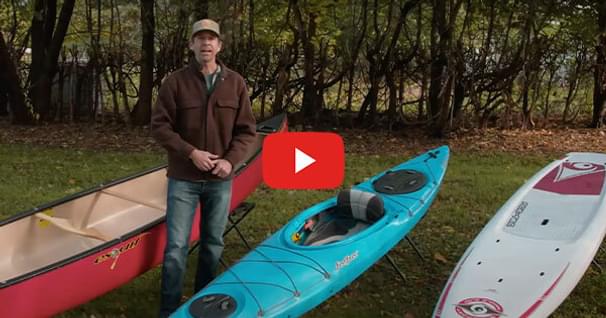Kayaking 101
The American Canoe Association has put together this fun animated video as a reminder for all paddlers to take responsibility for our own safety on the water!
Welcome to the world of kayaking.
There are a lot of things to consider when buying a kayak:
Recreational or Touring?
First, ask yourself if you're a serious paddler or you just want to paddle for fun. If you're here for fun, then recreational kayaks are for you. They're also affordable and are perfect for calm water conditions.
If you're here for the serious stuff like paddling for longer periods or improving your skills in kayaking then touring kayaks are for you. They're designed for challenging conditions that are tracking and maneuverability, but they are more expensive. Okay, so you've figured out what type of paddler you are, but there are still a lot of things to consider.
Sit-in or Sit-on-Top?
Now, let's take a closer look at the different types of kayaks.
A kayak can either be a sit in or sit on top.
Sit in kayaks have an enclosed cockpit but you can sit inside. This is perfect for cooler weather since you're somewhat protected, but it can be harder to get in and out of. Sit on top kayaks (SOT) have an open deck and are perfect if you want to swim, snorkel or fish and they're almost impossible to capsize.
50 years of lightweight, maneuverable, high-performing kayaks.
Check out this interview with Tom Keane, Eddyline Kayaks Co-Owner, on their journey!
Size?
A kayak can be wide or narrow, short or long. Wide kayaks tend to be more stable and they could handle more weight. Narrower kayaks are easier to paddle, more agile, track straighter and faster and offer better performance for more advanced kayakers.
Shorter models are lighter and easier to maneuver. Longer kayaks are faster, more agile, track straighter and generally perform better. They're also easier to paddle once up to speed and offer more storage capacity making them better suited for longer trips. Tandem kayaks are designed to hold two paddlers. They could be fun when you want to share your paddling experience with another.
Fishing kayaks?
Fishing kayaks are made specific for angling and come equipped with fishing specific features such as rod holders, cooler holders and multiple compartments for tackle boxes.
Lingo?
Here's some kayak terms you should know so you can ask the right questions when you go to buy your kayak:
• The front part of the kayak is called the BOW
• The back is called the STERN
• The COCKPIT is where you sit
• The DECK is the top of the kayak
• The HULL is the bottom of the kayak
• The BEAM is the widest part of the kayak usually mid ship
• PRIMARY STABILITY is how stable or tippy the kayak feels when you first sit in it
• SECONDARY STABILITY is how stable the kayak feels when it's underway especially on an edge during a turn
Hull Design
An important consideration is hull design. An understanding of hull design will help you pick the perfect kayak for you. Hull design involves trade-offs. That's because changing a shape for a desired attribute can require trading off another attribute. A flat bottom hull is very stable but tends to be slower. A V-bottom hull is fast but tends to be more tippy. A rounded V-bottom is a compromise between the two. Quicker than a flat bottom and more stable than a V-bottom and that does it.
You now have the basic information you need to purchase your kayak. Feel free to visit our website for more information.
See you on the water.
Related Articles
Ken Whiting answers the big question for new paddlers - Do you go for a canoe, a kayak, or a stand up…
The four fundamental dimensions for a kayak are kayak length, kayak width, kayak deck/cockpit height…
By changing how you edge and balance your boat you can increase your stability and adaptability. Using…
If you're in the market for a kayak or SUP make sure to check out used boats and boards to see if you…




